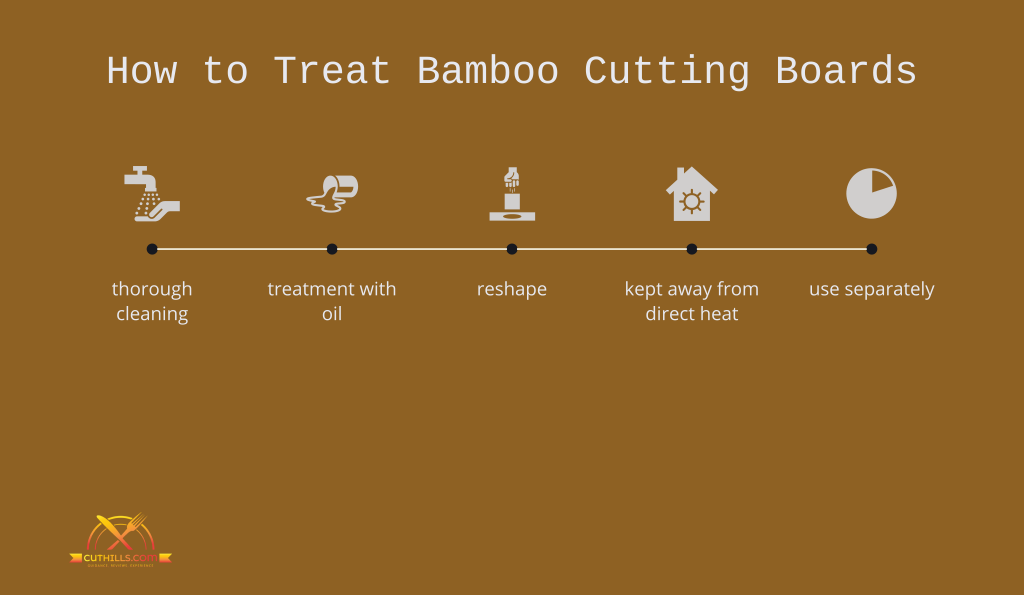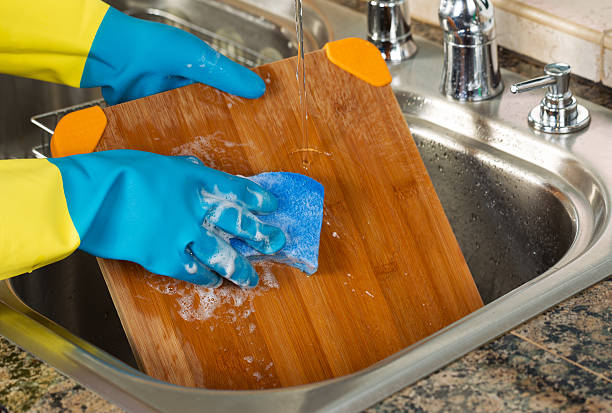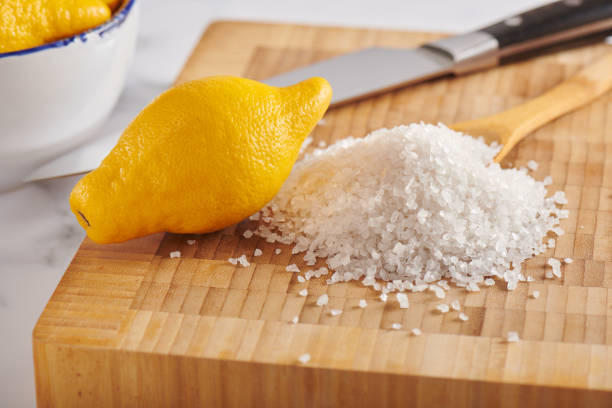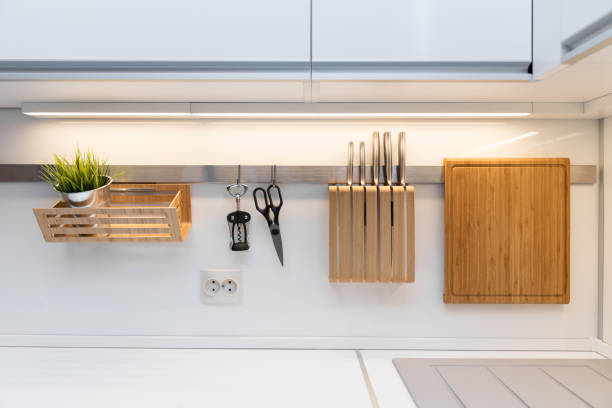In place of traditional wooden cutting boards, bamboo boards are a great option. The eco-friendliness, longevity, and adaptability of bamboo wood have made it a favorite among chefs. Since it doesn’t soak up water the same way other woods do, this one is considerably less likely to bend or split. Bamboo cutting boards, like any other type of board, require regular maintenance to stay in pristine shape. So, how to treat bamboo cutting boards?
To take care of a bamboo cutting board, you need to wipe it down, put oil on it, and smooth it out every so often. Scrubbing them after each use keeps germs from growing and keeps them in perfect shape. Maintaining a bamboo cutting board by oiling it once every few weeks will keep it from drying out and breaking. The flattening process creates a perfectly even surface for cutting.
What’s a Bamboo Cutting Board?
Cutting boards crafted from bamboo are simply called “bamboo cutting boards.” Cut from bamboo, the strips are carbonized, dried in a kiln to remove any moisture, and then bonded together to form a flat surface. The plank of wood is treated, sanded, and finished so that its finished surface is safe for use with food.
As a result of its unique properties, bamboo is perfect for use in making cutting boards. Since bamboo is grass and not a tree, it is a composite material made of lignin and cellulose fibers. Its strength comes from cellulose fibers. Because it has a lot of lignin fibers, bamboo is a stronger and longer-lasting building material than wood.
How to Treat Bamboo Cutting Boards: Knowing the Advantages and Disadvantages
Weighing the benefits and drawbacks of using bamboo cutting boards.
Bamboo Chopping Boards: Five Facts You Should Know
Before learning ways how to treat bamboo cutting boards, here are five things you might not know about it.
1. They Do Not Harm the Ecosystem in Any Way
Bamboo, despite its somewhat wooden look, is actually a very fast-growing grass. It is often used in organic farming because it is easy to grow and quickly grows back.
2. They Don’t Soak Up as much Liquid and Bacteria as Wood Does
Unlike wooden cutting boards, bamboo surfaces don’t absorb moisture due to their high density. As a result, they are just as hygienic as wood boards, if not more so, because no harmful germs can thrive inside the board.
3. It’s Possible that They’ll Dull Your Knives Quickly
Bamboo cutting boards are impervious to knife marks because of their dense texture. However, the boards’ hardness poses a risk to your high-quality cutlery, since it may dull the blades more quickly than would be the case with softer wood.
4. They Might Contain Formaldehyde
The glues used to make bamboo cutting boards that contain formaldehyde are bad for your health because the chemical can get into your food over time. Investigate the board’s building materials before making a purchase.
5. They Should Not Be Cleaned in the Dishwasher
Bamboo cutting boards may appear to be tough enough to put in the dishwasher, but you should avoid doing so. Use it as you would a regular wooden cutting board. It’s best to wash the board by hand in hot water and then dry it right away, rather than letting it sit in the water. Also, it needs to be oiled regularly to maintain its perfect look and keep it from cracking or warping.
How to Treat Bamboo Cutting Board: Treatment of Fresh Chopping Board

Crockery, utensils, pots and pans, and appliances are just a few of the things we have in our kitchen to help us prepare food. An item’s worth is determined by the significance it holds. It’s going to be a huge pain in the neck to try to cook without a knife and chopping board. None of us should be without these, as they form the bedrock of any good kitchen.
You can make a cutting board out of many different metals and non-metals, like plastic, silicone, wood, or bamboo. Bamboo is a sustainable, evergreen grass. They have greater tensile strength and durability than similar products, and they last longer.
Step 1: Proper Cleaning

The first step on how to treat bamboo cutting boards is to thoroughly clean them before and after each use. Put some mild cleaning solutions into lukewarm water and use that to wipe down the board. If you want to clean your bamboo cutting board, simply dip a cotton cloth into the soapy water and wipe the board down. Afterward, to clean the cutting board, just wipe it off with a moist towel and set it aside to dry. Add one tablespoon of bleach to a gallon of warm water and wipe down the board to kill any remaining bacteria.
Step 2: Bamboo Cutting Board with Oil
Another way how to treat bamboo cutting boards is to treat them with oil once every three weeks to keep them in top condition for daily usage. A food-safe oil can be put on the surface of the bamboo strands to keep them from drying out and cracking. Before using your bamboo chopping board for the first time, give it a light brush down with some food-grade oil to help preserve its condition for the long haul.
Safe Oils for Your Bamboo Cutting Board:
Many people don’t give much thought to their cutting boards because they’re just flat pieces of wood. Yet they do. Because it is made of organic stuff, wood is porous and ages differently as time passes. Therefore, it’s important that we know how to properly care for and oil a bamboo cutting board.
✅ Mineral Oil
Mineral oil, often known as “liquid paraffin,” is a safe and effective treatment that won’t dry out your skin. It lacks taste, smell, and color. Incredibly useful characteristics can be found in this oil. The mineral oil that is safe to eat is great for protecting wooden kitchen utensils like cutting boards and butcher blocks from moisture.
The term “food-safe” is crucial here because some forms of mineral oil are toxic to humans. Which mineral oil should you use? You might be underestimating how simple it actually is.
White mineral oil products have been approved for use in the food industry. Why? Compared to other mineral oils, these are the most refined. Always follow the product’s directions on the container if you have any doubts about how to use it.
✅ Coconut Oil (Fractionated)
Coconut oil’s popularity has skyrocketed due to its many uses. In particular, for its aesthetic value as a source of saturated fats, which are beneficial to the health of the skin and hair. Coconut oil goes bad in the same way that other fats do when they are exposed to air.
Instead, a fractionation technique is used to refine a subset of coconut oils. It aids in the removal of LCT, leaving only MCT. The resulting oil is so pure that it will not become rancid. To name only a few of the many kitchen items that can benefit from being treated with this variety of coconut oil: cutting boards, utensils, salad bowls, countertops, etc.

✅ Lemon Juice
Are you noticing a foul odor coming from your board? One simple method how to treat bamboo cutting boards is to rub the entire surface with half a lemon. When natural lemon oil is around, any water-soluble substances are also forced to evaporate.
✅ Walnut Oil
There are a couple of advantages and disadvantages to using walnut oil. First, it’s derived from nuts, so watch out for anyone with nut allergies. It’s pricey and will get rotten after a while. Walnut oil, on the other hand, has a pleasant aroma.
✅ Coconut Oil (Refined, Virgin, or Non-Processed)
As we’ve discussed, coconut oil is frequently used to keep cutting boards and chopping blocks in pristine condition. It doesn’t oxidize very quickly because it has a lot of saturated fat in it. As a result, it doesn’t become rancid easily. However, coconut oil-treated boards often develop a foul odor after prolonged use. Coconut oil can be used for a variety of purposes, including moisturizing the skin, making soap, frying food, and lighting candles. Despite the name, it contains no nuts.
✅ Vegetable Oils
A chopping board or counter should not be maintained with canola oil, corn oil, or sunflower oil. Eventually, the oils here will go rancid. Due to the unpleasant aftertaste and foul odor of the process, it is also extremely risky. Avoid using a cutting board made of a material that can go rancid, as it will come into contact with your food. The primary goal of every meal should be to satisfy your appetite.
Varnish
Varnishing is also known as shellac or lacquer. These are not appropriate maintenance tools for cutting boards. However, shellac and lacquer do more than just improve the wood’s appearance; they also protect it. Solvents are the primary component in most varnishes. Evaporating when the coating dries, it keeps liquids contained.
The resulting glue or binder serves to preserve the wood’s finish. Any sharp object, like a knife, will cause this residual resin to chip and peel off. We have two issues with this. To begin, the varnish itself may contain compounds that are harmful to humans. Second, food that has been varnished can no longer be enjoyed for either its flavor or its appearance.
Step 3: Wet and Warp
If your cutting board has become distorted from prolonged use, you can reshape it by wetting it and letting it warp back into shape. Fill the sink with hot or warm water, then soak your bamboo chopping board there.
You need to find a completely level surface to set the board on, and then use something heavy to keep it underwater. Any heavy, watertight object can be used to keep the board underwater for a long time, which gives the board time to change shape.
Step 4: Do Not Put It Near Any Machines
If you put your bamboo cutting board in the dishwasher, the heat and water will eventually crack it, so don’t do that. If you’re using a bamboo cutting board, you shouldn’t put anything hot directly on it. Never, ever consider putting it in a microwave. The cutting board should be kept away from any sources of direct heat.

Step 5: Use Separately
The easiest way to ensure that you have enough time to prepare your meals is to do so before you actually cook them. Bamboo cutting boards are great for chopping vegetables, but they should be disinfected after each use to prevent the transmission of germs and bacteria to the rest of your meals and the kitchen counters.
The Proper Time for a New Cutting Board
Wear and tear on the bamboo edge of a chopping board is to be expected with regular use. You should probably get a new cutting board if it’s looking worn. Indicators that your bamboo cutting board needs to be replaced are:
✽ Splits and Fissures Can be Seen on the Surface
Cracks provide a perfect habitat for bacteria on a cutting board. If you notice cracks in your cutting board, it’s time to replace it.
✽ There are Deep Grooves in the Surface
The deep grooves in your cutting board’s surface may also be a breeding ground for germs. When the surface of your cutting board becomes deeply grooved, it is time to replace it.
✽ Discoloration or a Lackluster Sheen
Your bamboo chopping board may experience discoloration or fading over time. You should probably get a new cutting board if you’re not satisfied with the current one.
✽ Distorting or Warping the Surface
The time may have come to get a new cutting board if it has started to warp or become deformed. It’s more difficult to use and may even harbor bacteria if your cutting board is warped or distorted.
Helpful Tips for Cleaning Stained Bamboo Cutting Boards
Stains from foods like beets and berries can be easily transferred to your bamboo cutting board. The oil used to polish your board can be damaged by foods high in citric acid, including citrus fruits or tomatoes. Salt, water, brushes, and wood chopping board oil are among the essential cleaning supplies recommended by experts.
- Pour plain water onto the board to dampen it.
- Leave the area of the stain exposed to salt overnight. If the substance you were cutting has any staining juices, the salt may help extract them.
- A coarse paste can be made by combining kosher salt and water. Apply this paste to a toothbrush and make the stain disappear by scrubbing it vigorously.
- Buff the spot with fine sandpaper if the stain persists.
- Please re-oil the board right away.
Frequently Asked Questions:
Q: Can I use olive oil to treat a bamboo cutting board?
Mineral oil suitable for human consumption is the only kind that can be used to cure bamboo. Olive oil should be avoided since it goes rancid and changes the flavor of food. Oils used in cooking can also go bad, and this includes things like olive oil, sunflower seeds, canola oil, and soybean oil.
Q: When should you re-oil your bamboo chopping board?
Once a month, use mineral oil that is safe for food on your bamboo cutting board. Regular use of a cutting board may necessitate more frequent oiling. Keep the oil application light. Too much oil will rise to the top and turn rancid.
Q: How long do bamboo cutting boards typically last?
When used regularly and with care, a bamboo cutting board can endure for up to ten years. Don’t put your cutting board through the wringer by using it frequently or cleaning it with strong chemicals. The high temperatures inside a dishwasher can also ruin a bamboo cutting board, so keep that in mind.
Final Thoughts
Simpler products, like bamboo cutting boards, are becoming more common as the market for kitchenware shifts toward items that can be used in both the dishwasher and the microwave. If your cutting board has been used, don’t trust young cooks to clean it up, as it may end up in the dishwasher. Bamboo cutting boards should be stored flat and unstacked to allow for air circulation.
Finally, keep it handy for any vegetable-related tasks! Following the steps above would be helpful in keeping your bamboo cutting board in good shape.
